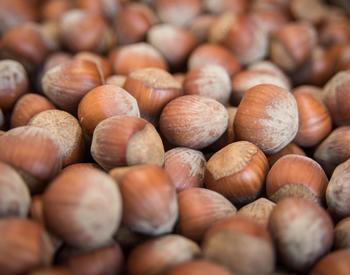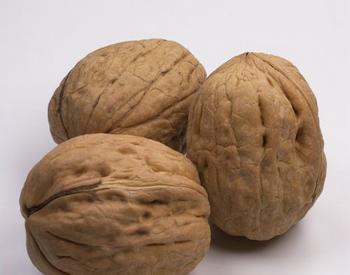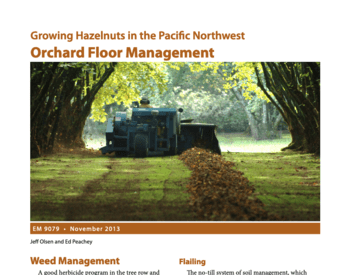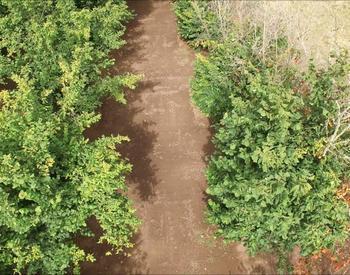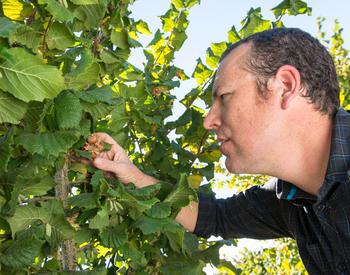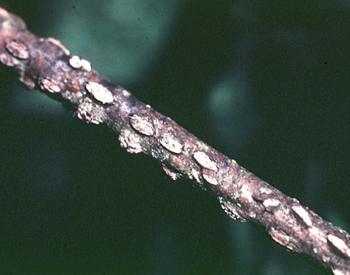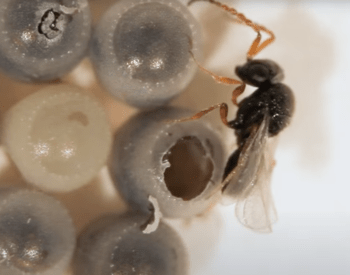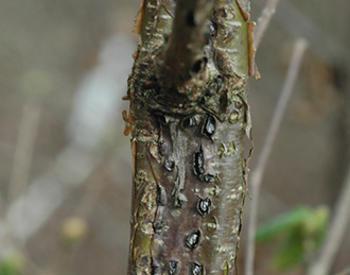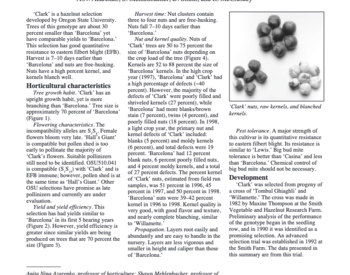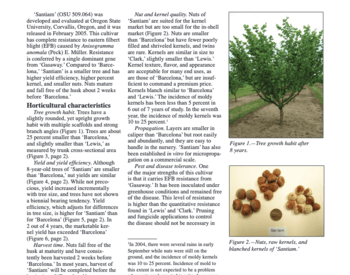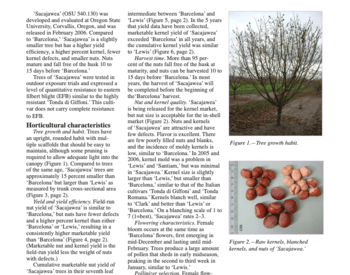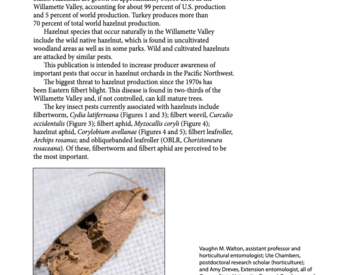Why train and prune hazelnut trees?
Training is done from planting up to 4–5 years old. It encourages a strong tree structure that can support heavy crops and withstand ice and snow loads.
Pruning is done to manage tree growth beyond its establishment phase and to give vigor to older trees. In hazelnuts, it is also a way to remove diseased or dead wood to extend the life of an orchard.
Defining terms
- Branch collar — The raised tissue at the base of every branch. It contains cells that seal off pruning wounds from wood rot fungi.
- Crotch angle — The angle formed between the trunk and a limb. The strongest crotch angle is 45–60 degrees.
- Crown — The part of the tree where the trunk meets the soil.
- Heading (or head cut) — A pruning cut that removes only part of a branch (Figure 1).
- Lateral branch — A side shoot off of another branch, usually at a more horizontal angle.
- Leader — The highest portion of a scaffold limb. In a central-leader trained tree, only one leader is left in the center of the tree. Multiple-leader trained trees usually have three to five leaders per tree.
- Scaffold limbs — Large limbs that form a tree’s framework.
- Shoot — The length of branch growth in one season. The bud scale scars (ring of small ridges) on a branch mark the start of a season’s growth.
- Stub — A short portion of a branch left after a pruning cut. Avoid leaving stubs.
- Sucker sprout — A 1-year-old shoot that grows from the root.
- Terminal — The apical (highest) end or shoot tip.
- Terminal bud — The bud at the end of a shoot marking the end of the current season’s growth.
- Thinning cut — A pruning cut that removes an entire branch from its point of origin (Figure 1).
- Training — Pruning in the early years after planting, to develop a structurally strong branch framework.
- Vertical branch — A branch that grows upright.
- Water sprout — A 1-year-old shoot that grows within the tree
Training
- Establishes structure and framework during years 1–5
Pruning
- Removes dead or diseased wood
- Increases light within the canopy, which can increase the number of flower buds and nut set
- Manages growth and keeps tree structure and framework balanced
- Reduces the tendency for biennial bearing in some cultivars if you make it a regular task
- Removes poorly placed limbs
- Gives new vigor for growth
- Allows for better spray coverage
- To be most productive, hazelnut trees should put on a minimum of 6–8 inches of new terminal shoot growth every year on shoots at shoulder height. Pruning helps maintain this growth.
General rules for pruning
- Prune at planting with a heading cut.
- Remove unwanted suckers every year when they’re small and before they’ve hardened off.
- Follow the pruning program without fail and as often as necessary so that you’re doing the training early. Remove unwanted branches when they’re small because smaller wounds heal over more quickly than larger wounds.
- Prune young trees lightly.
- Prune old trees more heavily, especially if they’ve shown little growth.
- Don’t try to overcome several years of neglect in one year. Don’t remove more than 25–30% of the living canopy at any one time.
- Hazelnuts can be pruned in the winter, spring, or summer. Pruning during winter (the dormant season) will cause the most vigorous growth the following spring. Spring or summer pruning produces much less return growth, and is useful in removing suckers and low-hanging limbs.
How to make the cut
- Prune branches so that you don’t leave stubs.
- Do NOT use wound dressing or paint.
- Hazelnut wood is very vulnerable to wood-rotting fungi, so it’s important to make thinning cuts at the branch collar where the branch attaches to a larger limb or the trunk.
Timeline
First year — Training
- Top the trees with a heading cut 28–34 inches from the ground at planting time. Transplanting shrinks the root system, and topping helps reduce moisture demand. Trees topped at planting generally become larger more quickly.
- Topping promotes the production of lots of leaders. If you make careful choices during the summer of the first year, these can become future scaffold branches. During the first dormant season, select 3–5 major limbs to become the scaffold branches (Figure 4A).
Second year — Training
- During the second winter, select one or two more scaffold branches (Figure 4B).
- Choose limbs that are evenly spaced around the tree trunk in different directions and have some vertical space between them (preferably at least 6 inches, or 15.2 cm).
- Remove all of the other limbs.
- If the primary scaffolds have grown more than 2 feet in length and failed to send out lateral shoots, head them to stimulate lateral branches.
Years 3–5 — Training
- By the third winter, choosing scaffold branches should be complete, and you can focus pruning on terminal branches to reduce crowding (Figure 4C).
- If you have trees with an upright growth habit, such as Jefferson, remove one or two upright branches in the middle of the tree in the fourth or fifth year to open up the tree (Figure 4D).
- Continue to make adjustments as in the second year with heading back or removing limbs growing too close to each other. Growers new to hazelnut trees tend to remove too much wood in the early years. Take out only what is clearly crowding, rubbing, and low hanging, and water sprouts.
Years 5–10 — Maintenance pruning
- During these middle years, pruning consists mostly of removing water sprouts, making thinning cuts in the interior of the canopy, and removing low-hanging limbs that interfere with spraying herbicides or machinery movement.
Renewal pruning in mature trees
- For production pruning, prune one-fifth of the orchard each year.
- Hazelnut yields may be reduced the first year after pruning, but they will recover in the following years. Start by removing diseased and dead wood.
- Remove limbs that are crossing or too close together.
- If you have trees with very dense canopies that have not been opened up, remove 1–3 upright limbs in the center to allow more light into the tree.
- Use thinning cuts to open up the canopy so that light penetrates all parts of the tree.
- Trees with very open growth habit, such as Yamhill, require less pruning and have naturally wide branch angles.
- A good general rule is to remove 25% (or less) of fruiting wood (wood with catkins).
- It’s good for the tree to remove some of the small, weak shoots to prevent overcrowding, but keep some of them to help prevent water sprouts from forming.
- Remove wood that is moss-covered and isn’t growing well, but leave large scaffold branches for growing new fruiting wood. Trim out center branches, and shorten low laterals. In the spring, remove suckers that are growing up through the canopy before they harden.
- Head back trees into 3- and 4-year old wood to stimulate new growth and maintain production in old, crowded trees (Figure 4). Make these cuts just above a lateral branch and be sure not to leave any dead stubs.
